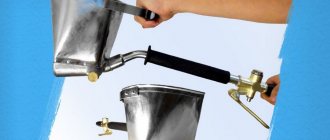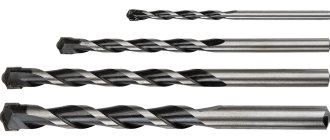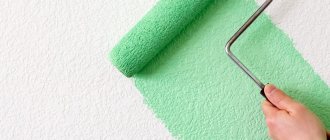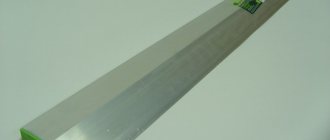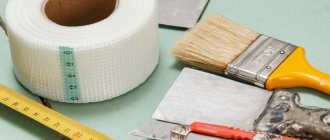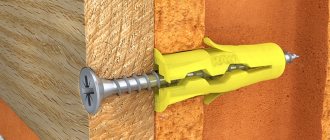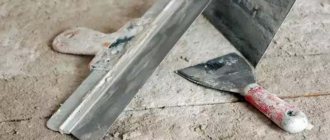Posted by inforadar on 04/29/201804/29/2018
To level walls, such a tool is often used, usually for plaster. It is a metal product with a sharp edge, which is used to remove excess solution and level the surface. Most often, the rule is used specifically for plastering; in fact, this tool is universal, you can carry out many operations with it.
Description of the tool
The term plastering rule itself means a tool that is used to correct defects and correct layers. But professionals use it for more diverse purposes. The tool may differ in size, as well as in the materials used in its production.
The term plastering rule itself means a tool that is used to correct defects and correct layers.
Which rule should you choose?
Which rule is best to purchase largely depends on its features:
- To perform external and internal work, the “STAYER Master 10723” model is relevant.
- The ideal option for processing horizontal and vertical sections is “Sibrteh 89607” or “ZUBR 10721”.
- If you plan to process various types of solution, then you should pay attention to “JETTOOLS 2.5 m”.
- For areas of any size, purchasing “Kraftool 10735-1.5” is relevant.
- “Matrix 89639” will help to correct the deviation of the plane from the verticals and horizontals.
- If versatility is a priority, then you need to pay attention to “SANTOOL 020621”.
- For those who want to purchase a long device, the best solution would be to purchase “ZUBR 10751”.
- STAYER Professional 10752 is characterized by high measurement accuracy.
- The “Stayer h-profile 2 m” is characterized by excellent value for money.
- Gigant ALRH25 and Stabila HAK can handle work of any complexity.
- If you are looking for a spatula and a rule in one, then “Melody of Color, 600 mm, stainless steel 0.3 mm ShP03-600” is the ideal option.
A correctly chosen rule will be an excellent assistant in construction and repair work. The rating presented the most versatile, functional, reliable and durable devices that can be ordered online through the Yandex Market Internet platform.
Scope of application
In addition to its direct purpose in the form of surface leveling, a number of other applications can be identified that will be useful during construction work:
- Assessment of the correct geometric shape of a building or position in space;
- Obtaining an even layer of plaster layer, screed;
- Making beacons from mixtures;
- Drawing straight lines;
- To securely support the glass cutter while it is working.
In addition to its direct purpose in the form of surface leveling, a number of other applications can be identified that will be useful during construction work.
The finishing layer of plaster is a covering.
After the inserts have dried, the wall is leveled in such a way as to cover all small scratches and small tool marks. To do this, prepare a liquid, creamy solution on fine sand, sifted through a 1.5x1.5mm sieve.
The sprayed covering is leveled with a wide spatula or trowel and carefully leveled, often wetting the tool.
The almost dry layer is “sanded” with a felt grater.
Such a wall becomes perfectly flat. data-matched-content-ui-type=”image_stacked” data-matched-content-rows-num=”2″ data-matched-content-columns-num=”3″ data-ad-format=”autorelaxed”>
Features of use
The nuances of applying the painting rule depend on the chosen task. It is also important to consider the size of the tool here. There are options that help create smooth corner areas.
It can be noted that if the edge is made of steel rather than aluminum, then it will work longer and be more durable. And it is usually chosen by professionals.
If the edge is made of steel rather than aluminum, then it will work longer and be more durable.
The best construction trowel rules
Melody of color, 600 mm, stainless steel 0.3mm ShP03-600
The stainless steel rule spatula is designed to prepare surfaces for subsequent finishing by eliminating defects and irregularities. When distributing plaster, the product works together with beacons. For maximum comfort when processing areas, the manufacturer has provided an ergonomic holder made of aluminum.
The popularity of this model is due to the possibility of replacing the canvas (a part of the same brand will do), which significantly affects the duration of the operational period. The blade of the unit must also be replaced. Moreover, the installation of blades of various thicknesses is supported. To allow smooth application of the material, they have rounded edges. The average price of the product is 2346 rubles.
Melody of color, 600 mm, stainless steel 0.3mm ShP03-600
Advantages:
- Light weight – 0.8 kg;
- Optimal dimensions – 150x600x60 mm;
- High quality;
- Affordable price;
- Long operational period.
Flaws:
- Not detected.
Varieties
Typically, tools for plastering work come in different shapes. To understand what the difference is between the types, and why it is better to choose converted options, you should study the features of each.
Typically, tools for plastering work come in different shapes.
H shaped rule
The plastering rule is a lightweight type, so it can be used to treat large areas. It does not put increased stress on the hands; a specialist will feel comfortable using the rule after he has plastered the surface; it is suitable for gypsum plasters of the Rotband type. But its low weight also does not allow the tool to be used for thick layers of plaster mixture.
The plastering rule is a lightweight type, so it can be used to treat large areas.
Trapezoid
This option is suitable for working with heavy solutions; thanks to its shape and the material used in production, it allows you to level long sections at once. Only in this case the simultaneous work of two masters is required.
This option is suitable for working with heavy solutions.
Rectangular
In terms of form, this is the simplest option. Not suitable for leveling walls as a rule; it is usually used when it comes to concrete screed. It is uncomfortable to control the surface with light.
There are options where a level is also included, but keep in mind that the bubble level often breaks. After all, increased loads are usually applied.
Not suitable for leveling walls as a rule; it is usually used when it comes to concrete screed.
Serrated
This is a subtype of the h-shaped tool. It is used for only one purpose, to apply adhesive plaster solutions. It is also noted that it works only with light mixtures.
It works only with light mixtures.
Angular
This is a highly specialized type; it is required when the corner sections of the wall are aligned; it is easier to get a 90-degree angle with it. For this reason, it cannot be adapted for other purposes after plastering.
It is required when the corner sections of the wall are leveled; it is easier to obtain a 90-degree angle with it.
Applying plaster mortar.
Plastering begins after the fixing solution has completely dried.
Plaster usually consists of three layers - spray, primer and cover. The first layer (spray) is applied with a liquid solution (the consistency of sour cream). This allows you to achieve the greatest adhesion to the wall surface.
After the covering has almost completely dried, the next (main) layer is applied - primer. To do this, apply the mortar onto the wall with a trowel or spatula. The density of the “slaps” should be as high as possible to provide excess (with a slight excess) coverage.
It is better to sketch in spans - wall fragments within the distance between two landmarks.
Plastering the walls between the lighthouses usually starts from below, from the floor.
Having covered the span completely, it is leveled: the rule is applied horizontally to the wall so that its edges rest on two beacons that limit the working area. The force is directed from bottom to top.
If, after smoothing with the rule, the plaster has dents and grooves, apply mortar over them and again “pass” with the rule. In this way, perfect evenness is achieved.
It is important to keep in mind some features of working with the rule:
- Do not press! The rule for cutting plaster is to remove excess mortar from the end. You should not press it with a wide plane (although this is more convenient), since it bends, making the wall not completely flat. Such a wall looks like alternating vertical panels, clearly visible even under the wallpaper.
- Damp. At first, when removing excess, you can work with a dry rule. But when finishing the work, in order to achieve the greatest smoothness, it is better to wet the rule.
- Care. Aluminum tools are quite flexible and easy to bend and deform. In addition, you should not let the cement harden on the surface of the rule; it is better to wash it periodically during the working day.
Dried mixtures will have to be cleaned with a hard tool, which will leave a lot of scratches on the aluminum. A rougher surface will become dirty even faster.
If it is decided not to remove the beacons, then the next layer (covering) is applied after the soil has almost completely dried.
What to look for when choosing a product
It is difficult for beginners to understand which tool is best to choose for doing plastering with their own hands. Therefore, you should figure out what criteria are important; this will be discussed below.
It is difficult for beginners to understand which tool is best to choose for doing plastering with their own hands.
Profile form
To understand which form will be suitable, you should study the features of each. They were discussed in the previous chapter. We can say that the trapezoidal look is more universal.
The trapezoidal look is more versatile.
Presence of stiffeners
Stiffening ribs make it easier to align, because when the rule is moved to remove excess mortar, they create forces, and in order for the tool to withstand such loads, additional reinforcements are needed. You can find out whether the rule has stiffening ribs if it has rubber plugs along the edges.
Stiffening ribs make the alignment process easier.
Correct geometry
To make accurate alignments, the slats need to be perfectly straight. The check is carried out as follows: on a flat surface, using an edge, draw a straight line, then turn the rod, placing it on the other side of the line, and again draw a horizontal strip. If the stripes match, then the instrument is good; if not, then you cannot purchase it.
To make accurate alignments, the slats need to be perfectly straight.
Material of manufacture
Previously, wood rules were used, but the short service life of these types was considered a disadvantage. Aluminum types are more practical. You can also find options with steel edges on sale, but they will be more expensive. A sharp edge is necessary for interior decoration; a rounded edge is suitable for facade decoration.
Aluminum types are more practical.
Product dimensions
Plastering will usually be carried out on different areas. And the sizes of the tools are different, it is better for a beginner to choose short types, otherwise it will be difficult to cope with the work. The longest are the three-meter rules; they are applicable only when the work is carried out by two masters.
It is better for a beginner to choose short types, otherwise it will be difficult to cope with the work.
Availability of level
The level allows you to simply control the evenness of the surface. However, there is a possibility that during increased movement the readings will be off; you should periodically check the correctness of the bubble measuring device.
The level allows you to simply control the evenness of the surface.
Material
- aluminum - modern and high-quality tools are made of light metal. They are light in weight, which is important for large volumes of work. But aluminum does not provide durability, and when working with plaster (especially with cement-sand mortars), the edge of the rule wears out over time. It develops unevenness and scratches that impair the quality of plastering;
- A steel edge stays straight longer
; aluminum with a steel working edge is usually the working part of which is reinforced with a strip of steel. It has all the advantages of an aluminum product. The special design prevents the possibility of tool bending; high-quality steel of the working edge extends the service life of the rule several times compared to the previous version. The main disadvantage is the high price of products made from combined materials; - wood is a cheap, disposable option. For work, slats with a smooth, polished edge are used. An obvious advantage is the possibility of making a wooden rule from available material. Increased hygroscopicity and a tendency to swelling and warping are disadvantages that cannot be corrected, even by thoroughly drying the product after the work.
How to work as a rule
Plastering walls can usually be done using beacons, which make the work easier, but sometimes they decide not to use them. You need to figure out how to proceed in both cases.
Plastering walls can usually be done using beacons, which make the work easier.
Working as a rule for beacons
Set the rule exactly along the beacons, and begin to slowly move along the applied primer layer. It is necessary to remove excess mixture in time, after which it must be moistened with water to avoid mixture residues.
The tool is pressed, but should not be pressed in.
Set the rule exactly along the beacons, and begin to slowly move along the applied primer layer.
Working as a rule without beacons
If it is decided to save money and eliminate the use of beacons, and there are no strong demands on the quality of the surface, then the method can be chosen. In this case, the tool should be equal to the length from the ceiling to the floor; it is moved along the mortar along the wall. Afterwards the surface is leveled with a spatula.
The tool should be equal in length from the ceiling to the floor; it is used to move along the mortar along the wall.
Placing and fixing beacons.
Before installing plaster guidelines, a full inspection of the room is carried out. The accuracy of angles, slope and deformation of walls are revealed. Plastering corners is an important finishing stage.
The geometric distortion of the walls is especially noticeable in the corners - they should be straight.
Installation by level.
The wall is examined with a plumb line - “weighed out”. In this way, they find the “zero” point - a place that will become a landmark, a standard.
Then screws are screwed into the wall, which will allow the beacons to be installed evenly.
First, they are screwed into the two upper corners.
Then, using a plumb line or vertical level, from below.
Beacons are oriented towards their exposed heads:
- Wooden ones are placed side by side so that their plane exactly matches the area of the screw head;
- The metal profile is applied directly to the screws.
Fix the slats with a solution, making some kind of “blunders” along the installation line.
Metal profile slats are quite flexible (made of tin), so for beginners it is advisable to rest them not on 2 screws, but on 4-6, screwed in in increments of 50 cm.
When the solution has set, all the voids under the guides are filled with it, and they are “coated” from the sides to achieve the most rigid fixation.
Having placed two landmarks at the corners, they begin to strengthen additional slats, if the length of the wall requires it.
2 screws are screwed into the wall between the batten and the corner, onto which the rope is secured. It should press tightly against the surface of the rail.
Now you can install as many guides as you like without resorting to precise and painstaking operations with a level.
The mixture used for plastering indoors is used as a fixing solution. But a gypsum-containing mixture is also used, which speeds up the work (gypsum hardens very quickly).
The thread can be stretched above the level of the slats. This is especially true for tin beacons - when pressed into the solution, they are easy to bend. Therefore, the rule for plaster applies here - it is applied to the lighthouse and pressed, leaning against its entire length. In this case, it is better to pull the rope at a distance from the slats equal to the width of the rule.
Laser installation.
The use of a construction laser makes the work easier: a special mark is applied to the rule (it is enough to draw a line with a simple pencil; it “sticks” perfectly to aluminum). The laser is installed so that it deviates from the ideal, “zero” point (the plane of the future plaster) to a distance equal to the width of the outlined fragment of the rule (see figure).
Thus, by pressing the guide, the worker strives to align the line drawn on it with the laser plane.
In this case, there is no need to pull ropes, weigh and screw in many screws.
As a rule, check the evenness of the wall
You can easily analyze the evenness of the base. The tool is placed with the sharp side to the surface; if there are any defects, the rail will wobble. Or, in the light, it will be noticeable that the edges of the device are hanging. The flowing areas will also be visible in the light.
You can easily analyze the evenness of the base.
The rule facilitates the process of plastering the surface; if the work is one-time, then there is no point in buying expensive steel variations or highly specialized types. In such a case, you can resort to making the tool yourself.
Best h-shaped building codes
Stayer h-profile 2 m
The two-meter rule is often purchased for finishing work. It is relevant in leveling both horizontal and vertical surfaces. On average, the price of the product is 1111 rubles.
For the manufacture of the “Stayer h-shaped profile 2 m” model, a lightweight material was used - aluminum alloy, which made it possible to achieve a low weight of the tool - 1.73 kg and its high strength. The unit is characterized by resistance to the occurrence of corrosion processes, as well as deformation and bending when damaged.
The special shape of the profile allows both the application of building mixtures and the removal of their excess. It is also responsible for additional structural rigidity. To prevent debris and other various mixtures from getting inside the housing, special half-packs made of durable plastic are installed on the sides of the device.
Stayer h-profile 2 m
Advantages:
- Durability;
- Affordable price;
- Ease of use;
- Optimal dimensions – 250x3x11.5 cm;
- The products comply with the standards and requirements of GOST;
- High strength.
Flaws:
- Not detected.
Gigant ALRH25
The construction rule is characterized by high resistance to mechanical and corrosion damage due to the fact that durable and wear-resistant aluminum was used for its manufacture. Good structural rigidity ensures a secure grip and maximum ease of use even over long periods of time.
Gigant ALRH25 is designed for processing cement-sand mixture when installing screed or pouring floors. Convenient shape, light weight (2.03 kg) and optimal dimensions (250x11.5x3 cm) of the model allow you to quickly cope with surfaces of both large and small areas. On average, the cost of this product is 1030 rubles.
Gigant ALRH25
Advantages:
- Long service life;
- High-quality assembly;
- Easy to use;
- Reliable grip;
- Efficiency.
Flaws:
- Not detected.
Stabila H.A.K.
The professional H-shaped tool is designed for finishing work on finishing materials such as plaster and plaster. Thanks to the presence of a grip, the profile fits comfortably in the hand, which contributes to high comfort during operation.
Stabila HAK has an optimal cross-section - 2.7x11.2 cm, weight - 1.11 kg and length - 1500 mm. Durable aluminum was used to produce the model, which made it possible to achieve high resistance to corrosion and possible deformation. The average price of a product is 1,702 rubles.
Stabila H.A.K.
Advantages:
- High quality (made in Germany);
- Affordable price;
- Wear resistance;
- Effective work;
- Ease of use.
Flaws:
- Short warranty period - 2 months.
